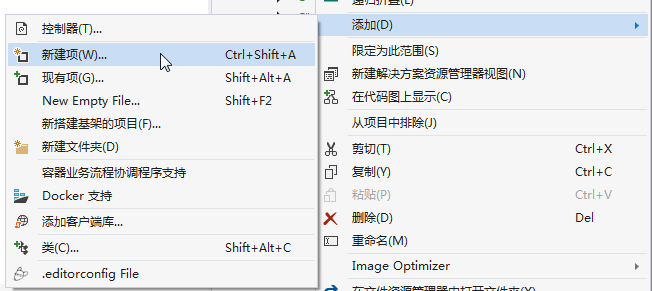abp(net core)+easyui+efcore实现仓储管理系统——使用 WEBAPI实现CURD (十二)
- 2019 年 10 月 3 日
- 筆記
abp(net core)+easyui+efcore实现仓储管理系统目录
abp(net core)+easyui+efcore实现仓储管理系统——ABP总体介绍(一)
abp(net core)+easyui+efcore实现仓储管理系统——解决方案介绍(二)
abp(net core)+easyui+efcore实现仓储管理系统——领域层创建实体(三)
abp(net core)+easyui+efcore实现仓储管理系统——定义仓储并实现 (四)
abp(net core)+easyui+efcore实现仓储管理系统——创建应用服务(五)
abp(net core)+easyui+efcore实现仓储管理系统——展现层实现增删改查之控制器(六)
abp(net core)+easyui+efcore实现仓储管理系统——展现层实现增删改查之列表视图(七)
abp(net core)+easyui+efcore实现仓储管理系统——展现层实现增删改查之增删改视图(八)
abp(net core)+easyui+efcore实现仓储管理系统——展现层实现增删改查之菜单与测试(九)
abp(net core)+easyui+efcore实现仓储管理系统——使用 WEBAPI实现CURD (十一)
上接(abp(net core)+easyui+efcore实现仓储管理系统——使用 WEBAPI实现CURD (十一)),在这一篇文章中我们创建服务接口与服务实现类,并创建控制器类。
二、定义应用服务接口需要用到的分页类
为了在进行查询时使用, PagedSupplierResultRequestDto被用来将模块数据传递到基础设施层.
1. 在Visual Studio 2017的“解决方案资源管理器”中,右键单击“ABP.TPLMS.Application”项目,在弹出菜单中选择“添加” > “新建文件夹”,并重命名为“Suppliers”
2. 使用鼠标右键单击我们刚才创建的“Suppliers”文件夹,在弹出菜单中选择“添加” > “新建文件夹”,并重命名为“Dto”。
3.右键单击“Dto”文件夹,然后选择“添加” > “类”。 将类命名为 PagedSupplierResultRequestDto,然后选择“添加”。代码如下。
using Abp.Application.Services.Dto; using System; using System.Collections.Generic; using System.Text; namespace ABP.TPLMS.Supplier.Dto { public class PagedSupplierResultRequestDto : PagedResultRequestDto { public string Keyword { get; set; } } }
4.右键单击“Dto”文件夹,然后选择“添加” > “类”。 将类命名为 SupplierDto,然后选择“添加”。代码如下。
using Abp.Application.Services.Dto; using Abp.AutoMapper; using ABP.TPLMS.Entitys; using System; using System.Collections.Generic; using System.Text; namespace ABP.TPLMS.Suppliers.Dto { [AutoMapFrom(typeof(Supplier))] public class SupplierDto : EntityDto<int> { public string Address { get; set; } public string Name { get; set; } public string Email { get; set; } public string Code { get; set; } public int Sex { get; set; } public string LinkName { get; set; } public int Status { get; set; } public string Tel { get; set; } public string Mobile { get; set; } public DateTime CreationTime { get; set; } } }
5.右键单击“Dto”文件夹,然后选择“添加” > “类”。 将类命名为 CreateUpdateSupplierDto,然后选择“添加”。代码如下。
using Abp.Application.Services.Dto; using Abp.AutoMapper; using ABP.TPLMS.Entitys; using System; using System.Collections.Generic; using System.ComponentModel.DataAnnotations; using System.Text; namespace ABP.TPLMS.Suppliers.Dto { [AutoMapTo(typeof(Supplier))] public class CreateUpdateSupplierDto : EntityDto<int> { public const int MaxLength = 255; [StringLength(MaxLength)] public string Address { get; set; } [Required] [StringLength(MaxLength)] public string Name { get; set; } [Required] [StringLength(MaxLength)] public string Email { get; set; } [Required] [StringLength(50)] public string Code { get; set; } public int Sex { get; set; } [StringLength(MaxLength)] public string LinkName { get; set; } public int Status { get; set; } [Required] [StringLength(MaxLength)] public string Tel { get; set; } [StringLength(MaxLength)] public string Mobile { get; set; } } }
三、定义ISupplierAppService接口
6. 在Visual Studio 2017的“解决方案资源管理器”中,鼠标右键单击“Suppliers”文件夹,然后选择“添加” > “新建项”,在弹出对话框中选择“接口”。为应用服务定义一个名为 ISupplierAppService 的接口。代码如下。
using Abp.Application.Services; using ABP.TPLMS.Suppliers.Dto; using System; using System.Collections.Generic; using System.Text; namespace ABP.TPLMS.Suppliers { public interface ISupplierAppService : IAsyncCrudAppService<//定义了CRUD方法 SupplierDto, //用来展示供应商 int, //Supplier实体的主键 PagedSupplierResultRequestDto, //获取供应商的时候用于分页 CreateUpdateSupplierDto, //用于创建供应商 CreateUpdateSupplierDto> //用于更新供应商 { } }
四、实现ISupplierAppService
7.在Visual Studio 2017的“解决方案资源管理器”中,右键单击“Suppliers”文件夹,然后选择“添加” > “新建项”,在弹出对话框中选择“类”。为应用服务定义一个名为 SupplierAppService 的服务类。代码如下。
using Abp.Application.Services; using Abp.Domain.Repositories; using ABP.TPLMS.Entitys; using ABP.TPLMS.Suppliers.Dto; using System; using System.Collections.Generic; using System.Text; namespace ABP.TPLMS.Suppliers { public class SupplierAppService :AsyncCrudAppService<Supplier, SupplierDto, int, PagedSupplierResultRequestDto, CreateUpdateSupplierDto, CreateUpdateSupplierDto>,ISupplierAppService { public SupplierAppService(IRepository<Supplier, int> repository) : base(repository) { } public override Task<SupplierDto> Create(CreateUpdateSupplierDto input) { var sin = input; return base.Create(input); } } }
五 创建SupplierController继承自TPLMSControllerBase
1. 在Visual Studio 2017的“解决方案资源管理器”中,右键单击在领域层“ABP.TPLMS.Web.Mvc”项目中的Controller目录。 选择“添加” > “新建项…”。如下图。

2. 在弹出对话框“添加新项-ABP.TPLMS.Web.Mvc”中选择“控制器类”,然后在名称输入框中输入“SupplierController”,然后点击“添加”按钮。如下图。

3.在SupplierController.cs文件中输入如下代码,通过构造函数注入对应用服务的依赖。
using System; using System.Collections.Generic; using System.Linq; using System.Threading.Tasks; using Abp.Application.Services.Dto; using Abp.AspNetCore.Mvc.Authorization; using Abp.Runtime.Validation; using ABP.TPLMS.Controllers; using ABP.TPLMS.Suppliers; using ABP.TPLMS.Suppliers.Dto; using ABP.TPLMS.Web.Models.Supplier; using Microsoft.AspNetCore.Mvc; using Microsoft.EntityFrameworkCore; namespace ABP.TPLMS.Web.Controllers { [AbpMvcAuthorize] public class SupplierController : TPLMSControllerBase { const int MaxNum= 10; // GET: /<controller>/ public async Task<IActionResult> Index() { var module = (await _supplierAppService.GetAll(new PagedSupplierResultRequestDto { MaxResultCount = MaxNum })).Items;
// Paging not implemented yet SupplierDto cuModule = module.First(); var model = new SupplierListViewModel { Supplier = cuModule, Suppliers=module }; return View(model); } private readonly ISupplierAppService _supplierAppService; public SupplierController(ISupplierAppService supplierAppService) { _supplierAppService = supplierAppService; } public async Task<ActionResult> EditSupplierModal(int moduleId) { var module = await _supplierAppService.Get(new EntityDto<int>(moduleId)); CreateUpdateSupplierDto cuSupplier = AutoMapper.Mapper.Map<CreateUpdateSupplierDto>(module); var model = new EditSupplierModalViewModel { Supplier = cuSupplier }; return View("_EditSupplierModal", model); } } }
